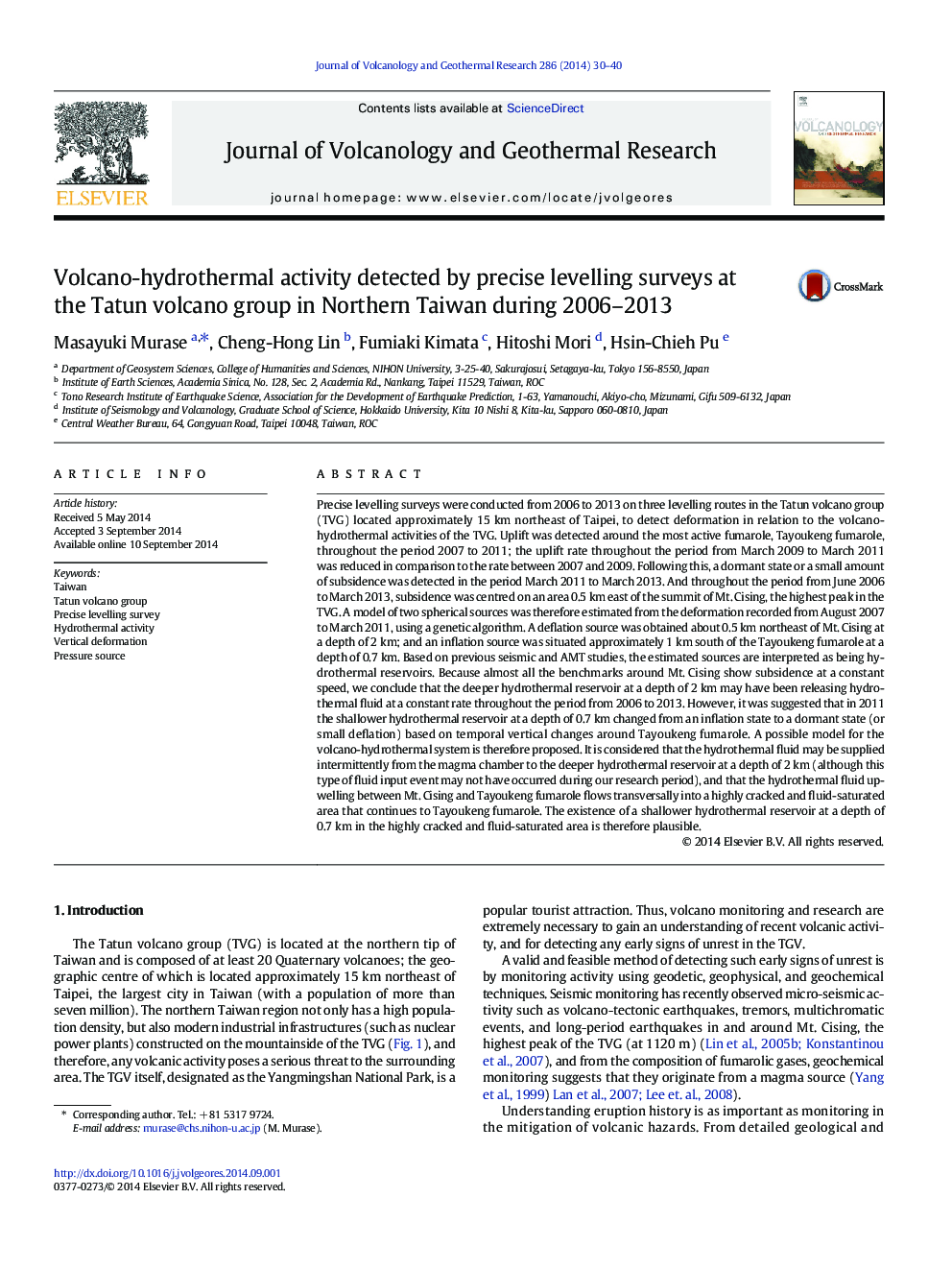| کد مقاله | کد نشریه | سال انتشار | مقاله انگلیسی | نسخه تمام متن |
|---|---|---|---|---|
| 6439654 | 1638336 | 2014 | 11 صفحه PDF | دانلود رایگان |

- A precise levelling survey was conducted in the Tatun volcano group.
- Uplift was detected around Tayoukeng, the most active fumarole, during 2007-2011.
- Subsidence was centred 0.5Â km east of Mt. Cising, the highest peak, during 2006-2013.
- A two-spherical-source model was developed using a genetic algorithm.
- Two spherical sources are interpreted as being hydrothermal reservoirs.
Precise levelling surveys were conducted from 2006 to 2013 on three levelling routes in the Tatun volcano group (TVG) located approximately 15Â km northeast of Taipei, to detect deformation in relation to the volcano-hydrothermal activities of the TVG. Uplift was detected around the most active fumarole, Tayoukeng fumarole, throughout the period 2007 to 2011; the uplift rate throughout the period from March 2009 to March 2011 was reduced in comparison to the rate between 2007 and 2009. Following this, a dormant state or a small amount of subsidence was detected in the period March 2011 to March 2013. And throughout the period from June 2006 to March 2013, subsidence was centred on an area 0.5Â km east of the summit of Mt. Cising, the highest peak in the TVG. A model of two spherical sources was therefore estimated from the deformation recorded from August 2007 to March 2011, using a genetic algorithm. A deflation source was obtained about 0.5Â km northeast of Mt. Cising at a depth of 2Â km; and an inflation source was situated approximately 1Â km south of the Tayoukeng fumarole at a depth of 0.7Â km. Based on previous seismic and AMT studies, the estimated sources are interpreted as being hydrothermal reservoirs. Because almost all the benchmarks around Mt. Cising show subsidence at a constant speed, we conclude that the deeper hydrothermal reservoir at a depth of 2Â km may have been releasing hydrothermal fluid at a constant rate throughout the period from 2006 to 2013. However, it was suggested that in 2011 the shallower hydrothermal reservoir at a depth of 0.7Â km changed from an inflation state to a dormant state (or small deflation) based on temporal vertical changes around Tayoukeng fumarole. A possible model for the volcano-hydrothermal system is therefore proposed. It is considered that the hydrothermal fluid may be supplied intermittently from the magma chamber to the deeper hydrothermal reservoir at a depth of 2Â km (although this type of fluid input event may not have occurred during our research period), and that the hydrothermal fluid upwelling between Mt. Cising and Tayoukeng fumarole flows transversally into a highly cracked and fluid-saturated area that continues to Tayoukeng fumarole. The existence of a shallower hydrothermal reservoir at a depth of 0.7Â km in the highly cracked and fluid-saturated area is therefore plausible.
Journal: Journal of Volcanology and Geothermal Research - Volume 286, 1 October 2014, Pages 30-40